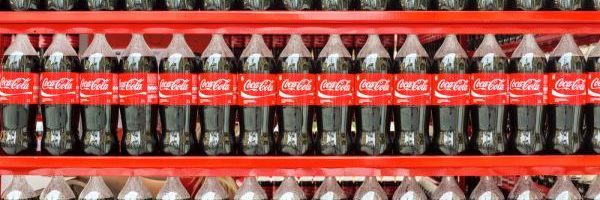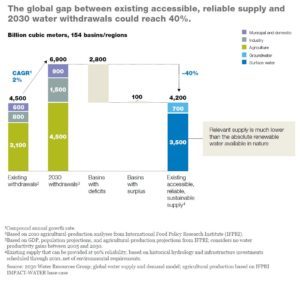Always Coca Cola?

How is the world's largest drinks manufacturer responding to an increasingly scarce supply of water?
Coca Cola is a contributor to, and victim of, climate change
That cold Coca Cola on your desk has gone through a lot to get there.
The carbon footprint of a single 330ml can is 170g/CO2, which is the result of: sourcing and producing packaging materials; growing, processing and transporting ingredients; manufacturing, distributing and chilling the product; and recycling the empty package1. Considering products from The Cola Company’s stable of beverages are enjoyed 1.9 billion times per day globally2 it is notable that the world’s largest drinks manufacturer has established an ambitious sustainability program which “seeks to drive system wide change beyond small operational improvements…and provide leadership that will raise the bar for our system and the industry3.”
The environmental protection element of the program focuses on: responsible water use; increasing recycling of packaging; reducing the carbon footprint of each drink produced and sustainable sourcing of agricultural products.
Coca Cola is not just a contributor to Climate Change, but also at risk from its physical manifestations. The Environment Agency (a UK Government body) acknowledges that those businesses most vulnerable to the effects of Climate Change are ones which4:
- Operate large, or long-lived fixed assets or buildings
- Have complex supply chains
- Are reliant on climatically sensitive inputs
The nature of Coca Cola’s business means it scores highly on all three of these criteria. I could focus on any of the above, but the scarcity of the company’s main ingredient seems a logical place to start.
Water is becoming increasingly scarce. Coca Cola needs a lot of it
300 billion liters of water were used to produce 151 billion liters of finished product across The Coca Cola company’s 500 drinks brands in 2015. An additional 15 billion liters of water were used by customers who sell fountain beverages, meaning 166 billion liters of water were contained in Coca Cola products. This figure does not include water which is embedded in products from the cultivation and processing of agricultural ingredients (such as sugarcane). It is estimated this accounts for 80% of Coca Cola’s total water footprint5, implying an annual water requirement of ~1,500 billion liters.
Global water withdrawals have tripled over the last 50 years to meet agricultural, industrial, and domestic demand6. Without action, global water demand could exceed supply by as much as 40% by 2030. Demand for water will continue to rise as industrialization and urbanization in emerging markets accelerates. Rising global temperatures may constrict the supply of water, and a less predictable climate means there could be greater uncertainty and volatility in future supply7.
Responsible water use is a key pillar of Coca Cola’s strategy…
Coca Cola has experienced first-hand direct impacts to its business stemming from (perceived) misuse of scarce water resources. In 2004 the company was forced to close a bottling plant in Kerala, India after it was accused of exceeding its permitted use of water during a time of drought8. This caused significant anger amongst the local population, approximately 70% of whom were dependent on agriculture – and the availability of water – for their livelihood.
Coke was ultimately found to have been acting within the law, but the company suffered reputational damage and consumers deserted the brand. This served as a catalyst for the company to adopt responsible water use as a key business priority9.
In 2007, Coca Cola committed that by 2020 it would replenish each liter of water used directly in its beverages. In 2015, Coca Cola replenished 191 billion liters of water, which is 115% of the 166 billion liters contained in its global sales volume; the company achieved its goal five years ahead of schedule10.
You can hear more from Coke’s Chief Sustainability Officer on how this was achieved here, and here.
…but the company needs to do more
Whilst this is unquestionably a laudable accomplishment, I believe Coke needs to do more.
191 billion liters is a drop in the ocean (approximately 13%) of the company’s estimated 1,500-billion-liter total annual water footprint. Coke needs to invest time and money in partnering with its suppliers – many of whom are poor farmers located in rural areas of developing countries – who are not well equipped to handle the pressures of a changing climate, or adopt modern, efficient, farming techniques.
Given that we expect demand for water to exceed supply in the near future, Coke still faces a real and pressing threat. The success the company has had to date (for example technical innovation resulting in improving water efficiency of its manufacturing processes11) should be shared with other manufacturers.
As previously noted, Coca Cola is committed to “raising the bar for the industry”. Now is the time for the world’s most recognizable drinks brand to turbocharge the role it plays in ensuring the most fundamental of all resources remains available to everyone.
(words: 795)
___________________
[2] http://www.coca-colacompany.com/careers/who-we-are-infographic
[3] http://www.coca-colacompany.com/stories/2020-sustainability-commitments
[4] Business Opportunities in a Changing Climate: Managing impacts and Market opportunities (written for the Environment Agency by Acclimatise) page 11, accessible at https://www.weadapt.org/sites/weadapt.org/files/ea_report.pdf
[5] http://www.coca-colacompany.com/stories/setting-a-new-goal-for-water-efficiency
[6] GEO-5 for Business: Impacts of a Changing Climate on the Corporate Sector, p.102-104, 436 Accessible at http://web.unep.org/geo/sites/unep.org.geo/files/documents/geo5_for_business.pdf
[7] Giulio Boccaletti, Sudeep Maitra, and Martin Stuchtey, “Transforming Water Economies,” McKinsey & Company, 2012, p. 1, accessible at https://www.mckinsey.com/~/media/McKinsey/dotcom/client_service/Sustainability/PDFs/McK%20on%20SRP/SRP_09_Water.ashx
[8] http://www.wsj.com/articles/coca-cola-closes-plant-in-india-1455122537
[9] http://www.coca-cola.co.uk/blog/our-water-wakeup-call
[10] http://www.coca-colacompany.com/stories/collaborating-to-replenish-the-water-we-use
[11] http://www.coca-colacompany.com/stories/setting-a-new-goal-for-water-efficiency




Great post. I didn’t realize how much they are doing to address the issue of replenishment. I’m curious about what that really means though – it was somewhat addressed in the video of the Sustainability Officer you referenced, but it seemed a bit vague. I wonder if those numbers aren’t a little inflated. Great to hear about the wastewater treatment initiatives at the source of usage though! I hope they are able to use their industry pull to influence others to match these practices.
It’s an interesting issue whether or not a global water supply shortage is good or bad for Coca-Cola. You could make the argument that it may be good:
1) Global water shortages will not restrict Coca-Cola’s access to water; rather, it will cause an increase in water needed to manufacture its products (so increase in raw materials cost)
2) All other beverage manufacturers will feel the same raw materials cost pressure –> beverage prices will increase across the board
3) Yes, consumers may reduce beverage consumption because of higher prices, but prices of almost everything edible will increase as water becomes costlier. For simplicity, let’s assume total beverage consumption is unchanged
4) Change in consumption of Coca-Cola products will then be determined by the relative price increase of Coca-Cola products vs. other beverage manufacturers, which would depend on the portion of total raw materials cost coming from water for Coca-Cola compared to other beverage manufacturers. This is not publicly available information, so it is unclear how Coca-Cola would stack up
5) Coca-Cola has relatively high margins (from their 10-K, Coca-Cola has ~20% operating margins vs. Pepsi at ~13-14%). Assuming similar business mix, this would support that Coca-Cola is better positioned to absorb higher input costs, given more margin cushion
Coke 10-K: https://www.sec.gov/Archives/edgar/data/21344/000002134416000050/a2015123110-k.htm
Pepsi 10-K: https://www.sec.gov/Archives/edgar/data/77476/000007747616000066/pepsico201510-k.htm
This was a very interesting post. I was particularly intrigued by the geopolitical considerations inherent in water scarcity/availability, particularly in Asia; I really appreciated your example of the bottling plant in Kerala. For some perspective on the scope of this issue in the decades to come: Asia is home to three-fifths of the world’s population but has less freshwater per capita than any other continent. [1] Zooming in on Asia’ two largest and most influential countries, China and India account for nearly 40% of the global population, but less than 11% of the world’s fresh water. [1] According to the World Bank, 9 out of 10 aquifers underneath major Chinese cities are polluted, and 300+ million Chinese lack access to safe drinking water. [2] I’m curious to see how Coca-Cola can brace for extreme geopolitical dislocation stemming from water availability.
[1] “Water: Asia’s New Battleground,” Brahma Chellaney, Georgetown University Press, 2012
[2] ‘Why We Care About the Price of Water in China,’ Peter Orszag, July 2011, https://www.bloomberg.com/view/articles/2011-07-06/why-we-care-about-the-price-of-water-in-china-peter-orszag, accessed Nov 2016
Great article mysterious author!
As a company with a large brand equity, Coca-Cola has a big role to play in climate change. Given their enormous marketing spend, it would be great if Coke dedicated more advertising dollars to drawing attention to the issue
This article poses an interesting question regarding responsibility, as it evaluates the difference in water usage associated with the actual raw materials of a bottle of Coke, versus the water expended in the cultivation and agriculture of key ingredients used in Coke. Coke has clearly demonstrated that they have made significant improvements in their ability to conserve and replenish water, as it easily surpassed its goal to replenish each liter of water used in its raw materials, earlier than their projected time horizon. There is an argument that can be made suggesting that if Coke could get to a point where it is replenishing water this quickly, then they probably can continue to make conservation steps related to their raw materials moving forward.
However, this does not mean that Coke should then in turn also be responsible for the water savings in the production of the agricultural products that are used to make the raw materials. With this thought process, wouldn’t companies like Hanes also be responsible for the water used in the agriculture associated with Cotton? Or wouldn’t every company be responsible for the electricity used to develop the raw materials in their supply chain? At what point does this responsibility fall on the eventual manufacturer, and at what point is this the responsibility of the agriculture industry? Now, with that being said, Coke can absolutely make efforts to reduce water use in agriculture, such as investing in drip irrigation systems that reduce evaporation and waste of water as it compares to spray systems, and can save up to 80% of the water used in traditional irrigation systems. [1] Yet, would Coke be doing this because they are responsible, or simply because they’re a company that happens to care about making a grander impact?
[1] “10 Ways Farmers Are Saving Water”.http://www.cuesa.org/article/10-ways-farmers-are-saving-water, accessed November 2016.